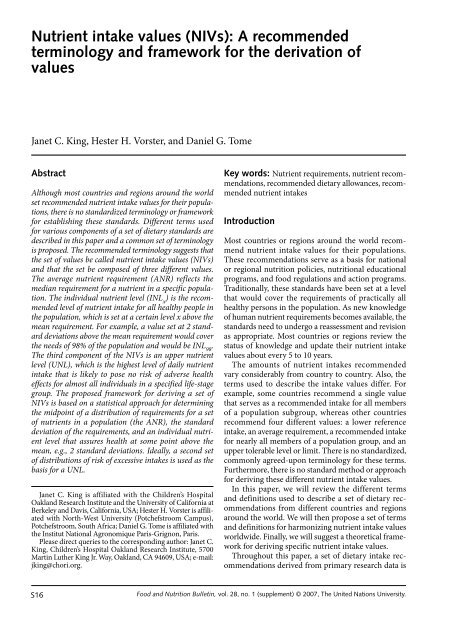Implementing food-based dietary guidelines for - United Nations ...
Implementing food-based dietary guidelines for - United Nations ...
Implementing food-based dietary guidelines for - United Nations ...
Create successful ePaper yourself
Turn your PDF publications into a flip-book with our unique Google optimized e-Paper software.
Nutrient intake values (NIVs): A recommended<br />
terminology and framework <strong>for</strong> the derivation of<br />
values<br />
Janet C. King, Hester H. Vorster, and Daniel G. Tome<br />
Abstract<br />
Although most countries and regions around the world<br />
set recommended nutrient intake values <strong>for</strong> their populations,<br />
there is no standardized terminology or framework<br />
<strong>for</strong> establishing these standards. Different terms used<br />
<strong>for</strong> various components of a set of <strong>dietary</strong> standards are<br />
described in this paper and a common set of terminology<br />
is proposed. The recommended terminology suggests that<br />
the set of values be called nutrient intake values (NIVs)<br />
and that the set be composed of three different values.<br />
The average nutrient requirement (ANR) reflects the<br />
median requirement <strong>for</strong> a nutrient in a specific population.<br />
The individual nutrient level (INL x ) is the recommended<br />
level of nutrient intake <strong>for</strong> all healthy people in<br />
the population, which is set at a certain level x above the<br />
mean requirement. For example, a value set at 2 standard<br />
deviations above the mean requirement would cover<br />
the needs of 98% of the population and would be INL 98 .<br />
The third component of the NIVs is an upper nutrient<br />
level (UNL), which is the highest level of daily nutrient<br />
intake that is likely to pose no risk of adverse health<br />
effects <strong>for</strong> almost all individuals in a specified life-stage<br />
group. The proposed framework <strong>for</strong> deriving a set of<br />
NIVs is <strong>based</strong> on a statistical approach <strong>for</strong> determining<br />
the midpoint of a distribution of requirements <strong>for</strong> a set<br />
of nutrients in a population (the ANR), the standard<br />
deviation of the requirements, and an individual nutrient<br />
level that assures health at some point above the<br />
mean, e.g., 2 standard deviations. Ideally, a second set<br />
of distributions of risk of excessive intakes is used as the<br />
basis <strong>for</strong> a UNL.<br />
Janet C. King is affiliated with the Children’s Hospital<br />
Oakland Research Institute and the University of Cali<strong>for</strong>nia at<br />
Berkeley and Davis, Cali<strong>for</strong>nia, USA; Hester H. Vorster is affiliated<br />
with North-West University (Potchefstroom Campus),<br />
Potchefstroom, South Africa; Daniel G. Tome is affiliated with<br />
the Institut National Agronomique Paris-Grignon, Paris.<br />
Please direct queries to the corresponding author: Janet C.<br />
King, Children’s Hospital Oakland Research Institute, 5700<br />
Martin Luther King Jr. Way, Oakland, CA 94609, USA; e-mail:<br />
jking@chori.org.<br />
S16<br />
Key words: Nutrient requirements, nutrient recommendations,<br />
recommended <strong>dietary</strong> allowances, recommended<br />
nutrient intakes<br />
Introduction<br />
Most countries or regions around the world recommend<br />
nutrient intake values <strong>for</strong> their populations.<br />
These recommendations serve as a basis <strong>for</strong> national<br />
or regional nutrition policies, nutritional educational<br />
programs, and <strong>food</strong> regulations and action programs.<br />
Traditionally, these standards have been set at a level<br />
that would cover the requirements of practically all<br />
healthy persons in the population. As new knowledge<br />
of human nutrient requirements becomes available, the<br />
standards need to undergo a reassessment and revision<br />
as appropriate. Most countries or regions review the<br />
status of knowledge and update their nutrient intake<br />
values about every 5 to 10 years.<br />
The amounts of nutrient intakes recommended<br />
vary considerably from country to country. Also, the<br />
terms used to describe the intake values differ. For<br />
example, some countries recommend a single value<br />
that serves as a recommended intake <strong>for</strong> all members<br />
of a population subgroup, whereas other countries<br />
recommend four different values: a lower reference<br />
intake, an average requirement, a recommended intake<br />
<strong>for</strong> nearly all members of a population group, and an<br />
upper tolerable level or limit. There is no standardized,<br />
commonly agreed-upon terminology <strong>for</strong> these terms.<br />
Furthermore, there is no standard method or approach<br />
<strong>for</strong> deriving these different nutrient intake values.<br />
In this paper, we will review the different terms<br />
and definitions used to describe a set of <strong>dietary</strong> recommendations<br />
from different countries and regions<br />
around the world. We will then propose a set of terms<br />
and definitions <strong>for</strong> harmonizing nutrient intake values<br />
worldwide. Finally, we will suggest a theoretical framework<br />
<strong>for</strong> deriving specific nutrient intake values.<br />
Throughout this paper, a set of <strong>dietary</strong> intake recommendations<br />
derived from primary research data is<br />
Food and Nutrition Bulletin, vol. 28, no. 1 (supplement) © 2007, The <strong>United</strong> <strong>Nations</strong> University.




